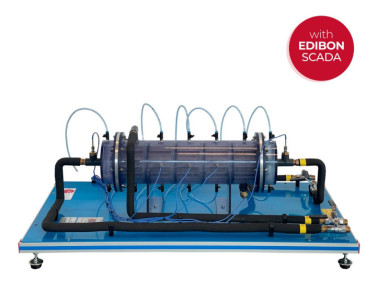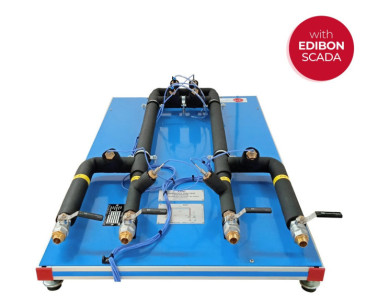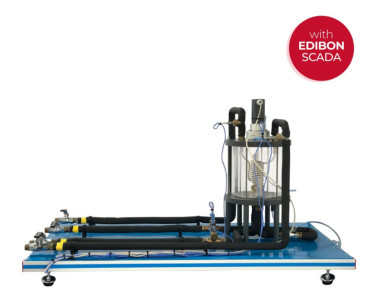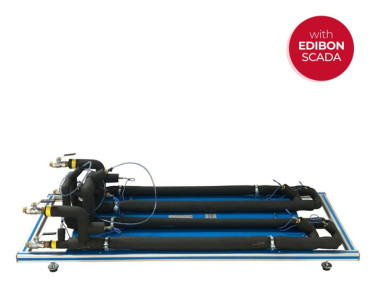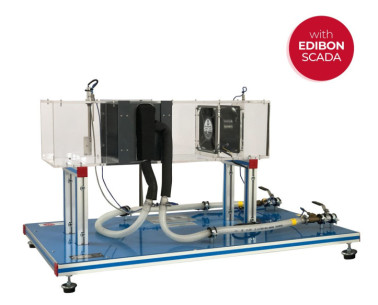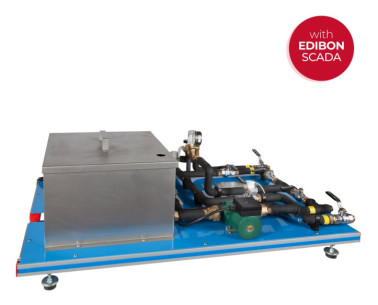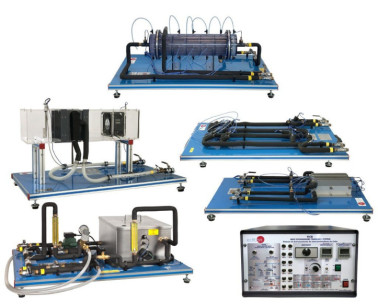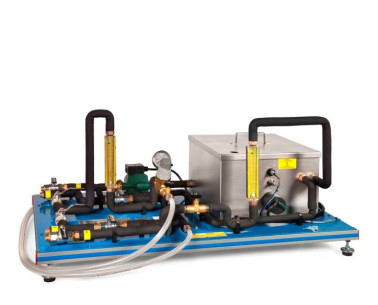TIFT Turbulent Flow Heat Exchanger for TICC
INNOVATIVE SYSTEMS
The Turbulent Flow Heat Exchanger for TICC, "TIFT", designed by EDIBON, provides a comprehensive environment for the detailed study of heat transfer between hot water flowing through an internal tube and cold water circulating in the annular space between the internal and external tubes. This unit facilitates the analysis of heat transfer variation under different conditions, including changes in flow rate, temperature, and flow type, whether counterflow or parallel.
Expansions
Laboratories
RELATED NEWS
General Description
Heat exchangers with turbulent flow are widely used in various industries such as chemical, food, pharmaceutical, and energy generation. These devices play a fundamental role in heating and cooling fluids, as well as in cooling systems for petroleum products and engines. Their optimized design ensures efficient heat transfer, contributing to precise temperature control in industrial processes.
The Turbulent Flow Heat Exchanger for TICC, "TIFT", designed by EDIBON, provides a comprehensive environment for the detailed study of heat transfer between hot water flowing through an internal tube and cold water circulating in the annular space between the internal and external tubes. This unit facilitates the analysis of heat transfer variation under different conditions, including changes in flow rate, temperature, and flow type, whether counterflow or parallel.
With a design optimized to enhance heat transfer efficiency, the Turbulent Flow Heat Exchanger for TICC provides an effective tool for thermal exchange analysis and experimentation. Additionally, it enables temperature measurement between the tubes, crucial for ensuring effective heat transfer and detecting potential issues. This capability facilitates monitoring the exchanger’s efficiency, identifying system faults, optimizing design, and understanding thermal distribution within the unit. Consequently, calculations such as overall energy balance in the exchanger and loss analysis, determination of exchanger effectiveness using the NTU method, study of heat transfer under counterflow and parallel flow conditions, analysis of flow rate influence on heat transfer through Reynolds number calculation, correlation between Nusselt number and Reynolds and Prandtl numbers, and determination of convective heat transfer coefficients can be performed.
These detailed measurements allow adjustment of the exchanger’s operation to enhance performance and ensure proper heat flow between circulating fluids. In summary, the Turbulent Flow Heat Exchanger for TICC, "TIFT", offers students, professors, and researchers the opportunity to thoroughly understand and apply the fundamental principles of heat transfer in such exchangers. Thanks to its innovative design, this unit enables detailed and applicable comprehension in the industry.
To work with this unit, the Base and Service Unit, "TIUS", is required, which provides key functions such as heating water using a thermostatic bath, pumping hot water, regulating and measuring the flow rates of cold and hot water, measuring the inlet and outlet temperatures of cold and hot water, as well as measuring the pressure drop in the heat exchanger.
These Computer Controlled Units are supplied with EDIBON Computer Control System (SCADA), and includes: The unit itself + a Control Interface Box + a Data Acquisition Board + Computer Control, Data Acquisition and Data Management Software Packages, for controlling the process and all parameters involved in the process.
Exercises and guided practices
GUIDED PRACTICAL EXERCISES INCLUDED IN THE MANUAL
- Global energy balance in the heat exchanger and loss study.
- Determination of the exchanger effectiveness. NTU Method.
- Study of the heat transfer in counter-current and co-current flow conditions.
- Flow influence on heat transfer. Reynolds number calculation.
- Obtaining of the correlation that relates Nusselt number with Reynolds number and Prandtl number.
- Obtaining of the heat transfer coefficients by convection.
- Sensors calibration.
MORE PRACTICAL EXERCISES TO BE DONE WITH THE UNIT
- Study of the hysteresis in the flow sensors.
Other possibilities to be done with this unit:
- Many students view results simultaneously. To view all results in real time in the classroom by means of a projector or an electronic whiteboard.
- Open Control, Multicontrol and Real Time Control. This unit allows intrinsically and/or extrinsically to change the span, gains, proportional, integral, derivative parameters, etc, in real time.
- The Computer Control System with SCADA and PID Control allow a real industrial simulation.
- This unit is totally safe as uses mechanical, electrical and electronic, and software safety devices.
- This unit can be used for doing applied research.
- This unit can be used for giving training courses to Industries even to other Technical Education Institutions.
- Control of the TICC unit process through the control interface box without the computer.
- Visualization of all the sensors values used in the TICC unit process.
- By using PLC-PI additional 19 more exercises can be done.
- Several other exercises can be done and designed by the user.
SIMILAR UNITS AVAILABLE
Shell & Tube Heat Exchanger for TICC
Concentric Tube Heat Exchanger for TICC
Jacketed Vessel Heat Exchanger for TICC
Coil Vessel Heat Exchanger for TICC
Extended Concentric Tube Heat Exchanger for TICC
Extended Plate Heat Exchanger for TICC
Cross Flow Heat Exchanger for TICC
SUPPLEMENTARY EQUIPMENT
Computer Controlled Heat Exchangers Training System
Base Service Unit (Common for all available Heat Exchangers type "TI")
Concentric Tube Heat Exchanger for TICC
Extended Concentric Tube Heat Exchanger for TICC
Plate Heat Exchanger for TICC
Extended Plate Heat Exchanger for TICC
Shell & Tube Heat Exchanger for TICC
Jacketed Vessel Heat Exchanger for TICC
Coil Vessel Heat Exchanger for TICC
Cross Flow Heat Exchanger for TICC
Heat exchanger Training System
Base Service Unit (Common for all available Heat Exchangers type "TI..B")
Quality

AFTER-SALES SERVICE

 Cookie preferences
Cookie preferences














